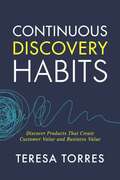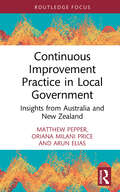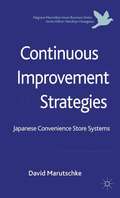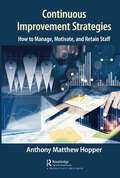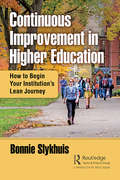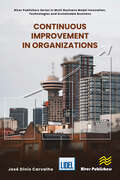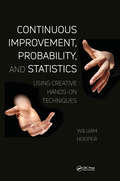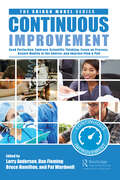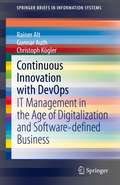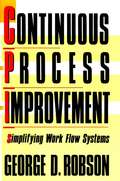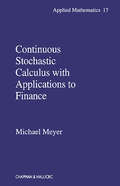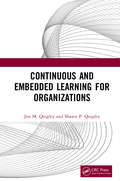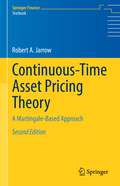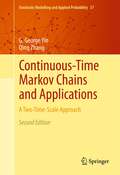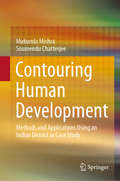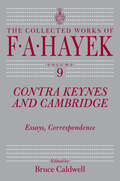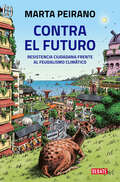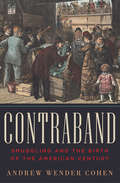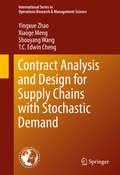- Table View
- List View
Continuous Casting Investments at USX Corp.
by Clayton M. ChristensenFocuses on the difficulty established companies face when confronted with disruptive technological innovations. The power that their prior asset investments, their cost structures, and their customers have in constraining their investment and innovation decisions are clearly illustrated. Rewritten version of an earlier case.
Continuous Cover Forestry: Assessment, Analysis, Scenarios (Managing Forest Ecosystems #23)
by Klaus Von Gadow Timo PukkalaAlthough the majority of the world's forest ecosystems are dominated by uneven-sized multi-species stands, forest management practice and theory has focused on the development of plantation monocultures to maximize the supply of timber at low cost. Societal expectations are changing, however, and uneven-aged multi-species ecosystems, selectively managed as Continuous Cover Forestry (CCF), are often believed to be superior to monocultures in addressing a wide range of expectations. This book presents methods which are relevant to CCF management and planning: analysing forest structures, silvicultural and planning, economic evaluation, based on examples in Europe, Asia, Africa and North and South America.
Continuous Discovery Habits: Discover Products That Create Customer Value and Business Value
by Teresa TorresHow do you know that you are making a product or service that your customers want? How do you ensure that you are improving it over time? How do you guarantee that your team is creating value for your customers in a way that creates value for your business? In this book, you'll learn a structured and sustainable approach to continuous discovery that will help you answer each of these questions, giving you the confidence to act while also preparing you to be wrong. You'll learn to balance action with doubt so that you can get started without being blindsided by what you don't get right. If you want to discover products that customers love-that also deliver business results-this book is for you.
Continuous Improvement Practice in Local Government: Insights from Australia and New Zealand (Routledge Focus on Business and Management)
by Matthew Pepper Oriana Milani Price Arun EliasLocal government plays a critical role in the provision of governance, infrastructure, and services for local communities. Over the past 30 years this sector has undergone significant reforms because of various superordinate governments policy changes. Continuous improvement and quality programs have been a common tactical response undertaken by various local government organisations to remain sustainable and to continue to deliver value to their local communities. These tactical responses have had varying levels of success. This book seeks to go beyond a tactical focus and uncover the kinds of continuous improvement practices that are enacted in various local government contexts. A focus on practices enables practitioners and researchers alike to gain insights that to go beyond approaches which privilege the application of CI tools over the contextualisation of CI programs. Contextualisation affords the insightful deployment of programs that are specific to the needs and dynamics of local communities and operations. The cases presented share insights on aspects of CI including: embedding performance measurement; harnessing learning; contextualising CI activities to support the ongoing sustainability of these practices. Researchers and practitioners alike can draw benefit from the grounded industry base experiences and insights shared in the book.
Continuous Improvement Strategies
by David MarutschkeThis book discusses continuous improvement strategies of Japanese convenience store operators. The study highlights the efforts of companies operating under lean management systems to identify new, dynamic, firm-specific capabilities in highly competitive markets.
Continuous Improvement Strategies: How to Manage, Motivate, and Retain Staff
by Anthony Matthew HopperDuring this era of continuous improvement, healthcare organizations need to be staffed by engaged, motivated, and hard-working frontline employees. As these clinical and non-clinical personnel handle most of the important tasks in any organization and are often the people who directly interact with patients and customers, it's the job of managers to oversee and motivate their staff members. Using Lean management strategies, this easy-to-read book for leaders and managers provides useful, insightful, and innovative information to help managers engage, motivate, and retain their employees during any Lean or other continuous improvement initiative.
Continuous Improvement in Higher Education: How to Begin Your Institution’s Lean Journey
by Bonnie SlykhuisIs your college or university struggling with how to adapt to budget cuts, changing student needs, technology, or regulatory changes? Do you have a program or staff assigned to help coordinate change efforts? Are you ready to become more proactive in how you react to the changes that affect your institution? Structured continuous process-improvement programs have benefitted manufacturing companies for decades, but what works in manufacturing does not work the same way in education! This book, written by a higher education Lean practitioner using real examples from higher education, shows you how to create a continuous-improvement program specifically for higher education It walks you through the key steps for building your first-year continuous-improvement plan. It provides templates, checklists, and best practices to assist in your planning process. Whether you are a Lean novice or a current Lean/continuous-improvement practitioner, this book will add tools to your tool kit and lay the groundwork for successful change initiatives.
Continuous Improvement in Organizations
by José Dinis CarvalhoThis book presents what you need to know to really implement continuous improvement in companies or other organizations. In addition to all the support needed for this to make sense, the importance of the right direction to guide it is unveiled. The reader will find in this book the origins of continuous improvement and all the framing that justifies and demystifies it in the aspects that characterize the socio-technical nature of organizations. This work also explores the need for effective coexistence between technical aspects and behavioral and cultural aspects, so that continuous improvement and excellence are achieved in organizations. Topics discussed in the book include: The origins of continuous improvement The main operational excellence models The invisible side of organizations The visible side of organizations Decoding continuous improvement The maturity levels of continuous improvement Some models and tips for the implementation of continuous improvement Main tools associated to excellence in organizations This book was written with the aim of helping engineering students in courses related to operations management to develop skills in this area, as well as businessmen with curiosity about this subject, production directors, people responsible for continuous improvement and all professionals working in companies or other organizations with responsibility for their performance and their future.
Continuous Improvement, Probability, and Statistics: Using Creative Hands-On Techniques (Continuous Improvement Series)
by William HooperWhat happens when the sport of Juggling meets a Statistical Process Control class? This book shows a creative approach to teaching data analysis for continuous improvement. Using step by step instructions, including over 65 photos and 40 graphs, traditional continuous improvement topics (design of experiments, reliability functions, and probability) are demonstrated using card illusions and hands-on activities. This book is for anyone that teaches these topics and wants to make them more understandable and sometimes even fun. Every operator, technician, student, manager, and leader can learn data analysis and be inspired to join the next generation of continuous improvement professionals.
Continuous Improvement: Seek Perfection, Embrace Scientific Thinking, Focus on Process, Assure Quality at the Source, and Improve Flow & Pull (The Shingo Model Series)
by Dan Fleming Larry Anderson Bruce Hamilton Pat WardwellIn this third book of the Shingo Model series, Continuous Improvement focuses on five of the Shingo Guiding Principles: seek perfection, embrace scientific thinking, focus on process, assure quality at the source, and improve flow and pull. Each chapter in Continuous Improvement is designed to enhance your comprehension of one or more aspects of the Continuous Improvement dimension of the Shingo Model and to increase your understanding of how the dimension interrelates with and complements the other principles in the Shingo Model. Ultimately, this explanation grounds the technical science of continuous improvement with a powerful social science that focuses on people development. It is this combination that creates the opportunity for improvement to be truly continuous. Because tacit learning is critical to deepening your continuous improvement knowledge, "Reader Challenges" are included throughout the text to encourage you to apply what you have read within the context of your own organization. This hands-on practice is necessary to understand the interrelatedness of principles, systems, and tools that are inherent in the Shingo Model. The Shingo Institute recognizes that "the transformation from traditional philosophy and practices to organizational excellence does not occur without the courage, creativity, and persistence of everyone in the organization—from executives to managers to team members on the frontline."
Continuous Innovation with DevOps: IT Management in the Age of Digitalization and Software-defined Business (SpringerBriefs in Information Systems)
by Rainer Alt Gunnar Auth Christoph KöglerThis book connects the new world of digitalization with classic IT management. With the presence of software in objects, products and processes, most businesses will become software-defined businesses. Software development and software management are thus key to stay competitive in an environment that demands continuous innovation. The authors provide a comprehensive introduction to continuous innovation, the DevOps concept and lay the foundations of an innovation-oriented IT management. The DevOps approach to continuous innovation, which combines lean and agile concepts with an automated tool chain, enables solutions that synergize fast (re)action through digital innovation on the one hand and long-term development cycles and stable operation on the other. A comprehensive case study of T-Systems MMS, a digital service provider from Deutsche Telekom in Germany, illustrates the use of this approach in practice.
Continuous Process Improvement
by George D. RobsonDuring the past decade Japanese companies have derived many of their competitive advantages from streamlined work-flow processes. Desperate to replicate the Japanese systems, American managers have bought into countless theories advanced by management consultants which, lacking a methodology, have proved fruitless and frustrating. Now, from inside a world-renowned learning organization, comes that methodology. Continuous Process Improvement (CPI) is an improvement and problem-prevention system created and developed by George Robson to "empower" natural work teams in three General Electric businesses. Composed of a logical set of steps, at the heart of which is "Process Flow Diagramming," CPI focuses on and simplifies the critical elements of work flow processes and eliminates those parts that add no value. Not only has this methodology helped these GE businesses save in excess of $35 million during the first two years of implementation, but similar techniques are now being employed by leading-edge companies throughout the world. CPI is a transportable system that not only has profoundly changed manufacturing practices, but has been applied with equal success in all areas of a business. Robson shows how the "Iceberg Phenomenon" can identify the measurable benefits of accurately accounting for direct and indirect costs by carefully tracking expenses. Planning for the true costs of customer service, marketing concessions, and retraining can turn unplanned losses into short- and long-term returns on investments. Robson focuses on activities that are critical to quality in design and production and demonstrates how non-value-added work can be eliminated. The staggering cost of re-work, calculated in "The Rule of Tens," is reduced by catching mistakes before they escape to subsequent stages of handling. The CPI system, which has been widely praised within General Electric, will be of broad interest throughout the business and university communities.
Continuous Software Development: Agile's Successor
by Jeffrey J. Bussgang Olivia Hull Samuel ClemensIn recent years, the twin software development methodologies of continuous delivery and continuous deployment have risen to prominence in the start-up world and beyond. These methods have enabled technology companies large and small to accelerate their product development pipelines and reshape their relationships with customers. Drawing on academic research and interviews with practitioners, this note explores the evolution of iterative approaches to software development, describes the mechanics of continuous development, and assesses the business benefits and challenges of rapid software testing and release.
Continuous Software Development: Agile’s Successor
by Jeffrey J. Bussgang Olivia Hull Samuel ClemensSenior Lecturer Jeffrey J. Bussgang, Entrepreneur-in-Residence Samuel Clemens, and Case Researcher Olivia Hull (Case Research & Writing Group) prepared this note as the basis for class discussion. Samuel Clemens is the founder and chief product officer of InsightSquared.
Continuous Stochastic Calculus with Applications to Finance
by Michael MeyerThe prolonged boom in the US and European stock markets has led to increased interest in the mathematics of security markets, most notably in the theory of stochastic integration. This text gives a rigorous development of the theory of stochastic integration as it applies to the valuation of derivative securities. It includes all the tools necessar
Continuous and Embedded Learning for Organizations
by Jon M. Quigley Shawn P. QuigleyThere is considerable connection between growth of the personnel in the organization and the ability for the company to compete over time. Looking outside for help training may be required but looking within for opportunities for enhanced training and growth, will foster a continually improving and growing organization. This book examines the opportunities for learning, within the organization and its’ activities, along with the connection to motivation. Additionally, it provides information on the characteristics of organizations that are able to quickly disseminate, along with approaches for improving this distribution of that learning throughout the organization.
Continuous-Time Asset Pricing Theory: A Martingale-Based Approach (Springer Finance)
by Robert A. JarrowAsset pricing theory yields deep insights into crucial market phenomena such as stock market bubbles. Now in a newly revised and updated edition, this textbook guides the reader through this theory and its applications to markets. The new edition features new results on state dependent preferences, a characterization of market efficiency and a more general presentation of multiple-factor models using only the assumptions of no arbitrage and no dominance. Taking an innovative approach based on martingales, the book presents advanced techniques of mathematical finance in a business and economics context, covering a range of relevant topics such as derivatives pricing and hedging, systematic risk, portfolio optimization, market efficiency, and equilibrium pricing models. For applications to high dimensional statistics and machine learning, new multi-factor models are given. This new edition integrates suicide trading strategies into the understanding of asset price bubbles, greatly enriching the overall presentation and further strengthening the book’s underlying theme of economic bubbles. Written by a leading expert in risk management, Continuous-Time Asset Pricing Theory is the first textbook on asset pricing theory with a martingale approach. Based on the author’s extensive teaching and research experience on the topic, it is particularly well suited for graduate students in business and economics with a strong mathematical background.
Continuous-Time Markov Chains and Applications: A Two-Time-Scale Approach (Stochastic Modelling and Applied Probability #37)
by Qing Zhang G. George YinThis book gives a systematic treatment of singularly perturbed systems that naturally arise in control and optimization, queueing networks, manufacturing systems, and financial engineering. It presents results on asymptotic expansions of solutions of Komogorov forward and backward equations, properties of functional occupation measures, exponential upper bounds, and functional limit results for Markov chains with weak and strong interactions. To bridge the gap between theory and applications, a large portion of the book is devoted to applications in controlled dynamic systems, production planning, and numerical methods for controlled Markovian systems with large-scale and complex structures in the real-world problems. This second edition has been updated throughout and includes two new chapters on asymptotic expansions of solutions for backward equations and hybrid LQG problems. The chapters on analytic and probabilistic properties of two-time-scale Markov chains have been almost completely rewritten and the notation has been streamlined and simplified. This book is written for applied mathematicians, engineers, operations researchers, and applied scientists. Selected material from the book can also be used for a one semester advanced graduate-level course in applied probability and stochastic processes.
Contouring Human Development: Methods and Applications Using an Indian District as Case Study
by Soumendu Chatterjee Mukunda MishraThis book acquaints readers with a range of techniques to help them effectively identify, record, map, analyze and report on patterns in various dimensions of human development (HD) with spatial scales down to the village level. It is impossible to capture HD at the local and global scale with only a single index, because differences in HD at the international scale are caused by ‘general’ factors, whereas local-scale differences are influenced by ‘specific’ factors. This book offers a variety of methods for scientifically mapping HD at any spatial scale. It covers how to rationally select variables; how to test the models; how to validate the results, and how to analyze them. For this purpose, it employs a case study on an Indian district. The socio-economic factors regulating the patterns of HD are now more complex than they were only a few decades ago, making it essential to incorporate newer models in order to successfully ‘replicate’ the real-world situation. Accordingly, the book offers essential methodological tools & techniques for mapping HD. It sheds new light on a handful of statistical multivariate analysis and machine learning algorithms that are rarely used in the social sciences when dealing with HD, yet have sound mathematical and statistical bases. These techniques can be successfully used for predictive analysis in the earth & natural sciences, decision sciences and management disciplines, and are equally effective in terms of capturing, predicting and projecting the composite HD ‘landscape.’ This book will especially benefit two groups of readers: firstly, HD practitioners who want to find out ‘why some areas are doing better than others’ by exploring the complex interactions of spatially linked variables with different HD parameters. And secondly, practitioners in other branches of the social sciences who are not concerned with HD but are looking for ‘hands-on training’ with techniques they can apply in their respective field of spatial investigations.
Contra Keynes and Cambridge: Essays, Correspondence (The Collected Works of F. A. Hayek #9)
by F. A. HayekIn 1931, when the young F. A. Hayek challenged the economic theories of John Maynard Keynes, sixteen years his senior, and one of the world's leading economists, he sparked a spirited debate that would influence economic policy in democratic countries for decades. Their extensive exchange lasted until Keynes's death in 1946, and is reprinted in its entirety in this latest volume of The Collected Works of F. A. Hayek. When the journal Economica published a review of Keynes's Treatise on Money by Hayek in 1931, Keynes's response consisted principlally of an attack on Hayek's own work on monetary theory, Prices and Production. Conducted almost entirely in economics journals, the battle that followed revealed two very different responses to a world in economic crisis. Keynes sought a revision of the liberal political order—arguing for greater government intervention in the hope of protecting against the painful fluctuations of the business cycle. Hayek instead warned that state involvement would cause irreparable damage to the economy. This volume begins with Hayek's 1963 reminiscence "The Economics of the 1930s as Seen from London," which has never been published before. The articles, letters, and reviews from journals published in the 1930s are followed by Hayek's later reflections on Keynes's work and influence. The Introduction by Bruce Caldwell puts the debate in context, providing detailed information about the economists in Keynes's circle at Cambridge, their role in the acceptance of his ideas, and the ways in which theory affected policy during the interwar period. Caldwell calls the debate between Hayek and Keynes "a battle for the minds of the rising generation of British-trained economists." There is no doubt that Keynes won the battle during his lifetime. Now, when many of Hayek's ideas have been vindicated by the collapse of collectivist economies and the revival of the free market around the world, this book clarifies Hayek's work on monetary theory—formed in heated opposition to Keynes—and illuminates his efforts to fight protectionism in an age of economic crisis. F. A. Hayek (1899-1992), recipient of the Medal of Freedom in 1991 and co-winner of the Nobel Memorial Prize in Economics in 1974, was a pioneer in monetary theory and the principal proponent of classical liberal thought in the twentieth century. He taught at the University of London, the University of Chicago, and the University of Freiburg.
Contra el futuro: Resistencia ciudadana frente al feudalismo climático
by Marta PeiranoTras advertirnos de los peligros de internet, vuelve Marta Peirano con un nuevo relato antiapocalíptico para construir un futuro esperanzador. Es la historia más vieja del mundo: la de un desastre medioambiental y una tecnología que nos salva. La hemos repetido como un mantra desde el principio de los tiempos porque hasta ahora se ha revelado cierta; somos el animal más peligroso de la sabana, hemos vencido a las bestias, a las tormentas y a la enfermedad. Pero la estrategia evolutiva que nos ha mantenido vivos desde el principio de la misma vida nos empuja ahora al borde de la extinción. Estamos tan atrapados que ya nos parece inevitable. No es un problema técnico. Hay soluciones a nuestro alcance para frenar el calentamiento global. Pero las grandes tecnologías de nuestro tiempo no pueden ayudarnos a gestionar la crisis climática, porque no están diseñadas para ello, sino para gestionarnos a nosotros durante la crisis climática. Este libro habla de las estrategias de acción ciudadana para hacer frente a la aceleración del feudalismo climático y el capitalismo desastre. Un nuevo relato antiapocalíptico para construir un futuro esperanzador. La crítica ha dicho:«Una de las raras periodistas que realmente se ha especializado en la intersección de la tecnología y el poder».Edward Snowden «Marta Peirano es una de las voces más respetadas en nuestro país sobre privacidad y seguridad en internet».Manuel Ángel Méndez, El Confidencial «Marta Peirano es una incitadora a la resistencia ciudadana. Es la única periodista que analiza la relación entre la Tecnología y el Poder».Mamen Mendizábal
Contraband
by Michael KwassLouis Mandrin led a gang of bandits who brazenly smuggled contraband into eighteenth-century France. Michael Kwass brings new life to the legend of this Gallic Robin Hood and the thriving underworld he helped to create. Decades before the storming of the Bastille, surging world trade excited a revolution in consumption that transformed the French kingdom. Contraband exposes the dark side of this early phase of globalization, revealing hidden connections between illicit commerce, criminality, and popular revolt. France's economic system was tailor-made for an enterprising outlaw like Mandrin. As French subjects began to crave colonial products, Louis XIV lined the royal coffers by imposing a state monopoly on tobacco from America and an embargo on brilliantly colored calico cloth from India. Vigorous black markets arose through which traffickers fed these exotic goods to eager French consumers. Flouting the law with unparalleled panache, Mandrin captured widespread public attention to become a symbol of a defiant underground. This furtive economy generated violent clashes between gangs of smugglers and customs agents in the borderlands. Eventually, Mandrin was captured by French troops and put to death in a brutal public execution intended to demonstrate the king's absolute authority. But the spectacle only cemented Mandrin's status as a rebel folk hero in an age of mounting discontent. Amid cycles of underground rebellion and agonizing penal repression, the memory of Mandrin inspired ordinary subjects and Enlightenment philosophers alike to challenge royal power and forge a movement for radical political change.
Contraband: Smuggling and the Birth of the American Century
by Andrew Wender CohenHow skirting the law once defined America’s relation to the world. In the frigid winter of 1875, Charles L. Lawrence made international headlines when he was arrested for smuggling silk worth $60 million into the United States. An intimate of Boss Tweed, gloriously dubbed “The Prince of Smugglers,” and the head of a network spanning four continents and lasting half a decade, Lawrence scandalized a nation whose founders themselves had once dabbled in contraband. Since the Revolution itself, smuggling had tested the patriotism of the American people. Distrusting foreign goods, Congress instituted high tariffs on most imports. Protecting the nation was the custom house, which waged a “war on smuggling,” inspecting every traveler for illicitly imported silk, opium, tobacco, sugar, diamonds, and art. The Civil War’s blockade of the Confederacy heightened the obsession with contraband, but smuggling entered its prime during the Gilded Age, when characters like assassin Louis Bieral, economist “The Parsee Merchant,” Congressman Ben Butler, and actress Rose Eytinge tempted consumers with illicit foreign luxuries. Only as the United States became a global power with World War I did smuggling lose its scurvy romance. Meticulously researched, Contraband explores the history of smuggling to illuminate the broader history of the United States, its power, its politics, and its culture.
Contract Analysis and Design for Supply Chains with Stochastic Demand (International Series in Operations Research & Management Science #234)
by Shouyang Wang T. C. Edwin Cheng Yingxue Zhao Xiaoge MengThis book is devoted to analysis and design of supply chain contracts with stochastic demand. Given the extensive utilization of contracts in supply chains, the issues concerning contract analysis and design are extremely important for supply chain management (SCM), and substantial research has been developed to address those issues over the past years. Despite the abundance of classical research, new research needs to be conducted in response to new issues emerging with the recent changing business environments, such as the fast-shortening life cycle of product and the increasing globalization of supply chains. This book addresses these issues, with the intention to present new research on how to apply contracts to improve SCM. Contract Analysis and Design for Supply Chains with Stochastic Demand contains eight chapters and each chapter is summarized as follows: Chapter 1 provides a comprehensive review of the classical development of supply chain contracts. Chapter 2 examines the effects of demand uncertainty on the applicability of buyback contracts. Chapter 3 conducts a mean-risk analysis for wholesale price contracts, taking into account contracting value risk and risk preferences. Chapter 4 studies the optimization of product service system by franchise fee contracts in the service-oriented manufacturing supply chain with demand information asymmetry. Chapter 5 develops a bidirectional option contract model and explores the optimal contracting decisions and supply chain coordination issue with the bidirectional option. Chapter 6 addresses supply chain options pricing issue and a value-based pricing scheme is developed for the supply chain options. With a cooperative game theory approach, Chapter 7 explores the issues concerning supply chain contract selection/implementation with the option contract under consideration. Chapter 8 concludes the book and suggests worthy directions for future research.
Contract Drafting
by Paul A. SwegleContract Drafting and Negotiation for Entrepreneurs and Business Professionals


